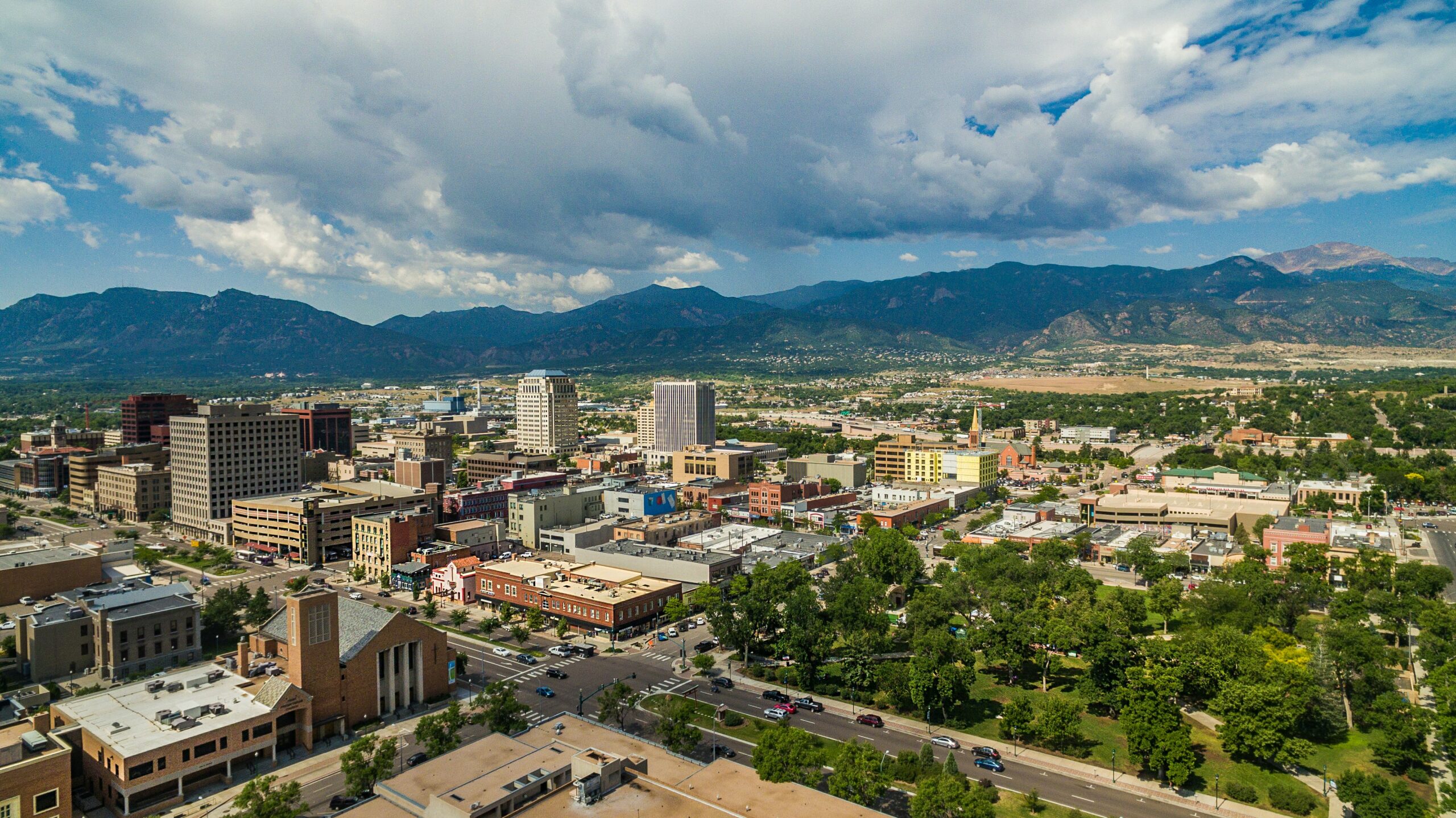Office Sector
The Colorado Springs office market is facing demand challenges. However, as of the third quarter, trailing 12-month absorption bounced back into positive territory, amounting to 200,000 SF. Vacancies have decreased by half a percentage point in the past year to 10.4%. Still, the vacancy rate remains near the highest to be recorded dating back to 2014.
To a certain degree, the city is in better shape than most comparable markets and has avoided the worst of the disruption that most other areas are facing due to changing office utilization patterns, and vacancies remain below the national benchmark of 13.9%. With no projects under construction, the market has no supply-side risk in the near term, which should help in keeping vacancies in check. According to CoStar’s Base Case forecast, vacancies in Colorado Springs are projected to remain relatively flat going forward, while national vacancies are projected to continue rising through 2026.
Rent growth is outperforming the national average at about 1.9% positive annual gains, compared with 1.0% rent gains from the national index. However, when adjusting for inflation, real rent growth continues to trend negative.
Colorado Springs is an affordable market and has benefitted as some investors have been priced out of core gateway markets. The city has attracted investors in the pandemic era due to its growing population and highly skilled workforce.
Leasing
Annual absorption has bounced back into positive territory, amounting to 200,000 SF. Vacancy now registers 10.4%. While vacancy remains elevated relative to historic standards, it still remains below the national benchmark of 13.9% as the local market has not been as impacted by changing office utilization patterns that have swept the nation. However, the Colorado Springs market still has a sizeable amount of sublease inventory to work through with 350,000 SF available, representing 1.1% of the market.
Leasing activity picked up in the past year. Nooks LLC, a company that offers classified spaces as a service for both industry and government customers, signed the largest lease, taking 57,727 SF at NorthCreek Office Complex in the Northwest Submarket. The company took occupancy in September. The acceleration in leasing activity will likely help to keep vacancies in check.
CoStar’s Base Case forecast calls for vacancies to remain relatively flat through the end of the year.
Industrial Sector
Demand in the Colorado Springs industrial market has been steady over the past few years, driven by aerospace, defense, manufacturing, and cybersecurity. The vacancy rate sits at 4.4%, below the national average of 6.8%. Annual net absorption amounted to 640,000 SF. The market has limited supply-pressure with space under construction amounting to 610,000 SF, representing just 1.4% of current inventory.
E-commerce is booming, but retail sales at brick-and-mortar locations have also risen, leading to increased demand for distribution centers across the city where goods can be stored before reaching the consumer. Retailers and logistics providers are increasing their industrial footprints to improve their distribution networks and bulk up on inventories. Tenants have spread out across the market, but East Colorado Springs, near the airport, continues to drive the majority of logistics demand.
While demand has held steady, rent growth has decelerated in the past year to just 1.4%. Rents have held up best in Teller County and Southeast Colorado Springs. The pace of rent growth remains below the national annual average of 3.0%. CoStar’s base case forecast projects annual rent growth to increase by 1.1% in 2024 before rebounding in 2025.
Construction
While most markets across the U.S. experienced a run up in construction activity in the last year, the pipeline in Colorado Springs has remained steady. About 610,000 SF is currently under construction, representing just 1.4% of the market’s current inventory.
The current pipeline is concentrated in the Southeast Submarket near the Colorado Springs Airport, where Amazon opened its massive, 4-million-SF distribution center in the third quarter of 2021. Amazon’s distribution site has the capacity to employ over a thousand workers and has become an economic driver in the historically distressed southeastern part of the city.
About 200,000 SF is under construction in the Southeast Submarket, on top of the 340,000 SF that has delivered in the past year. PepsiCo broke ground on its new 115,000-SF distribution facility in early 2023. According to a press release from PepsiCo, the new Colorado Springs facility will deliver in early 2024 and will “expand supply chain operations for popular product brands such as Pepsi, Gatorade, Celsius, and Rockstar, and boost future growth in southern Colorado for years to come.”
New construction starts for speculative projects have slowed in the past year as developers find it increasingly difficult to obtain financing. The pipeline is projected to remain minimal over the next year in this high interest rate environment.
Retail Sector
The Colorado Springs retail market remains in a position of strength. With 41,000 SF delivered in the past year and another 240,000 SF under construction, the supply pipeline is beginning to put upward pressure on vacancies. Still, the vacancy rate remains near historic lows as of the third quarter.
Most of the development underway is either near downtown Colorado Springs, or in the rapidly growing northern part of the metro along Interstate 25. These parts of the metro boast high, or rising, population density, relatively high incomes, and—especially in North Colorado Springs, proximity to Denver. Migration from the Denver metro to the Colorado Springs metro has provided a not-insignificant boost to population growth, and the northern part of Colorado Springs is a more likely destination for these entrants.
Midway through 2024, leasing is active in the Colorado Springs retail market, driven by quick service restaurants. In-N-Out, Whataburger, Popeyes, and Subway, to name a few, opened locations within the last year. Vacancy in the general retail segment has fallen to just 2.8%. This segment has also benefited from growth in discounters, cellular service retailers, and retailers in the home improvement categories. Meanwhile, mall vacancies remain stubbornly high at 12.9%. Availabilities in Chapel Hills Mall and The Citadel are primary drivers of elevated mall vacancies. The mall sector has struggled to gain traction on a macro basis, even as retail as a whole has posted a strong comeback.
The top-performing submarkets in Colorado Springs are those charging the highest rents, and by extension, the submarkets which have the best locations and retail demographics. The Northeast Submarket commands the highest retail rents in the metro by a notable margin, nearly $24/SF. Rent growth in the submarket has continuously outpaced the metro average for over five years.
Sales
Growing confidence in the retail sector has fueled investment volume with $231 million in Colorado Springs assets trading in the last 12 months, marginally below the five year annual average of $332 million. General retail properties are driving transaction volume, accounting for $129 million in sales in the past year.
In the current high interest rate environment, the buyer pool has shifted predominately to small private investors who target single-tenant net-leased deals valued under $5 million. These buyers frequently pay in all cash to take advantage of 1031 tax-deferred exchanges, making them less reliant on the debt markets than large institutional buyers and REITS. Roughly 80% of transactions involved a private buyer in the past year. Cap rates in this tier tend to be on the lower end of the spectrum, but have generally moved upward since the beginning of 2022.
For example, a private California-based investor purchased a newly-built drive-thru in the Northeast Submarket for $2.55 million, or $1,096/SF in December 2023 at one of the lowest cap rates reported in the past year, at 4.31%. The freestanding building has a new 15-year lease with Chipotle and was purchased in cash.
The number of deals closing above $5 million is limited, with the largest deals in the past year focused on deals in high-growth areas with higher cap rates owing to the heightened risk in this tier as well as the more management-intensive nature of these assets.
For example, the 2003-built Ridgeview Marketplace in the Northeast Submarket sold in July for $9.7 million to Phillip Edison & Company. The property is anchored by King Soopers and was 99% leased at the time of sale to 12 tenants, giving the buyer dual opportunity of a stable cash-flow investment that could also be improved in ways that would add value over a longer hold period. The asset traded at a 6.52% cap rate.
Colorado Springs Economy
In the 4th quarter of 2024, Colorado Springs is expected to see continued growth in its economy, driven by a combination of military presence, tech sector expansion, and population growth. The city’s close proximity to Denver and relatively affordable living costs make it attractive to businesses and individuals alike. The unemployment rate remains low, and industries such as aerospace, defense, and cybersecurity, with companies like Lockheed Martin and Northrop Grumman, continue to bolster the economy. Population growth also fuels the service, healthcare, and education sectors, providing a solid base for future economic stability.
Commercial real estate in Colorado Springs is positioned for steady demand, particularly in sectors related to office spaces, industrial developments, and mixed-use properties. The tech sector’s expansion, combined with military contractors and government services, creates a need for modern office spaces, with emphasis on flexibility and advanced infrastructure. Retail real estate may experience mixed performance, as e-commerce continues to challenge traditional brick-and-mortar establishments, but mixed-use developments that incorporate residential, commercial, and recreational spaces are expected to thrive.
Looking ahead to the end of 2024 and into 2025, the outlook for commercial real estate in Colorado Springs is cautiously optimistic. Demand for industrial spaces, especially warehousing and logistics, remains strong, driven by the city’s role as a regional hub. However, rising interest rates and potential economic cooling could moderate the pace of new construction and investments. Investors will likely remain focused on high-demand sectors like healthcare, industrial, and multifamily developments, which are expected to be resilient to broader market fluctuations.

